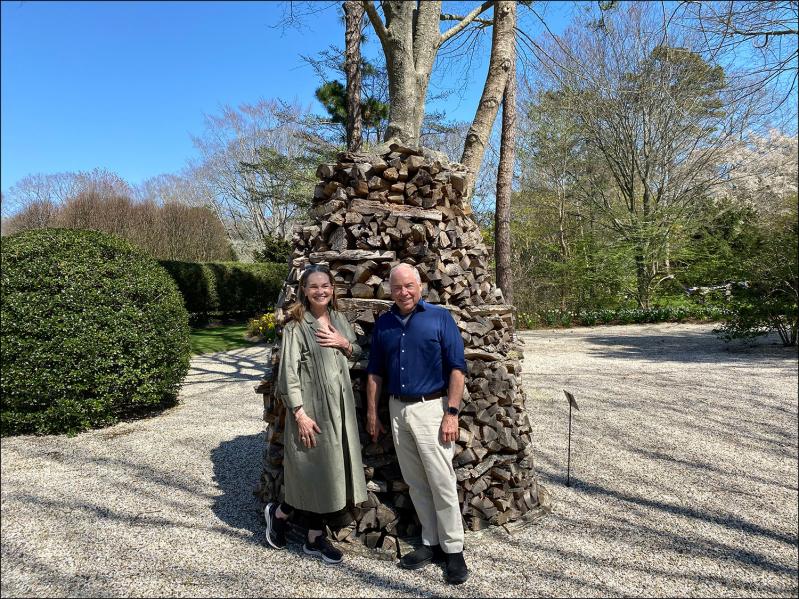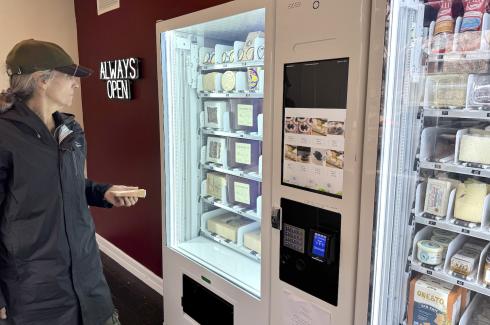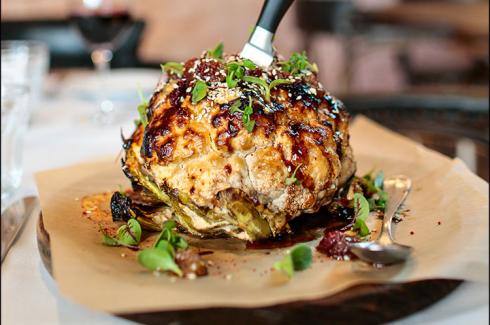LongHouse Reserve, East Hampton’s 16-acre sculpture garden and nature sanctuary, is heading into the high season with a rich schedule of art, special events, performances, conversations, art and craft workshops, well-being activities, and, of course, the garden that has been named one of the top 15 most peaceful places in New York State.
“It’s a garden of ideas,” said Carrie Rebora Barratt, the venue’s director. “More and more native plants are added every year. We are a pollinator garden, which means birds, butterflies, lots of birds, lots of bees, lots of butterflies. I think gardens are art, too. If our mission is to encourage living with art in all forms, the plants are art, too.”
“One of the things people don’t realize is that gardens evolve,” Louis Bradbury, the president of LongHouse’s board, said. “They can’t stay the way Jack did them, because trees grow, trees die. What we’re trying to do now is to let people know that gardens change by the month.” Jack Lenor Larsen, who died in 2020, was LongHouse’s founder.
The art changes, too. There is the permanent collection, which includes works by Buckminster Fuller, Yoko Ono, Barbara Shawcroft, and Toshiko Takaezu, as well as renewed loans of sculpture by Maren Hassinger, Sol LeWitt, Fitzhugh Karol, Mark Mennin, and Kenny Scharf, many of which are moved around from year to year.
“What Jack left us were what I call three white pillars of the garden, the Buckminster Fuller ‘Fly’s Eye Dome,’ the Sol LeWitt ‘Irregular Progression,’ and the Yoko Ono chess set,” Ms. Barratt said. “Those are three really iconic works by masters of contemporary art, and they were all friends of Jack.”
This year will feature new work by Hangama Amiri, Alice Hope, Jill Platner, and Vadis Turner. Ms. Turner has designed “Venus Rising,” which will stand upright in the Red Garden. Created out of braided bedsheets cast in aluminum, with scalloped edges made with cast dining plates, the piece references flora and flame, misbehaviors and transcendence, according to LongHouse.
Ms. Platner is a sculptor and jeweler. When Ms. Barratt visited her studio in SoHo, “astonishingly beautiful mobiles were hanging from the ceiling. I said, ‘Where have you shown them?’ She said, ‘Nowhere.’ That was the beginning of our conversation.”
Ms. Platner’s “Talking With Trees” consists of 67 elongated metal sculptures in various sizes hanging from tree branches in the Dawn Redwood Forest. With curves and bends that replicate the patterns of nature, the sculptures move with the wind. As for the redwoods, Mr. Bradbury said, “Most people don’t know that we have a big collection of them.”
Magnets, can tabs, and ball chain are some of the unusual materials Ms. Hope transforms into objects and installations. For LongHouse she has built a series of balls made of Lucite and wooden rulers she has collected and fastened together to create geometric orbs. “They look like a cross between a beach ball and the Fuller dome,” Ms. Barratt said, and they will be placed inside and around it.
Born in Kabul, Afghanistan, Ms. Amiri fled with her family in 1996, when she was 7 years old, and, after moving through numerous countries, they immigrated to Canada in 2005. She earned a B.F.A. from the Nova Scotia College of Art and Design and an M.F.A. from Yale University.
She combines painting and printmaking techniques with textiles, creating stories based on memories of her homeland, including the colors and fabrics in the bazaars of Kabul, and her diasporic experience. Her representational works are made from layering fabrics, piecing and sewing them together to examine how gender, social norms, and geopolitical conflict affect the lives of women.
One unusual piece of sculpture is a Holzstapel, German for woodpile, which has been constructed by Mr. Bradbury, Jason Amis, head of operations and facilities, and Josue Rojas, one of the venue’s gardeners. Mr. Bradbury built his first on his own property because he had no place to put all the firewood he had split. The logs are piled in a circular beehive shape, and gravity holds them together. The structure at LongHouse is roughly eight feet tall and five feet in diameter at its base.
Among the upcoming special events are Pride ‘25 at LongHouse Reserve, set for June 21 outdoors. A fund-raiser for Hamptons Pride, it will include dance music by D.J. Watts, musical performances, local wine and beer and hors d’oeuvres, as well as a silent auction featuring 30 trays decorated by artists, a private cruise, an electric bike, and a director-led tour of LongHouse with cocktails for 10.
“Luminosity,” on July 12, LongHouse’s summer benefit, will honor the artist Vija Celmins and the philanthropists Mary Jane and Charles Brock. Cocktails, hors d’oeuvres, an art auction, and entertainment will be followed by dinner, a tribute to the honorees, and dancing. Organized by Mary Gail Doerhoefer, LongHouse’s head of collections and exhibitions, and Pamela Willoughby, a curator and gallerist, the auction will offer pieces from renowned and emerging artists.

Looking further ahead, “One of the exciting things we hope to have ready for next year is people coming into the house,” Mr. Bradbury said, adding that certain upgrades are required to allow it. “We have the largest public collection of furniture by Wharton Esherick in the world, but no one gets to see it. It was Jack’s desire that the house be open to the public.”
Alastair Gordon, the artist, historian, and architecture critic, will return to host Long Island Modern, a series of conversations that focuses on postwar modernist architecture. Other talks will be by Michael Jones, from Robert A.M. Stern Architects, who will discuss the architecture of Central Park South, and a series of conversations led by Edwina von Gal that will explore our relationship with life on Earth.
On Saturday at 3 p.m., Kevin Wiecks, the director of Bayard Cutting Arboretum in Great River, will discuss his career in public horticulture and the importance of informed plant selection to have a meaningful impact on the public landscape. Tickets are $35, $25 for members.
Artist talks and tours will take place throughout the season with Ms. Amiri, Ms. Platner, Ms. Turner, and Mr. Mennin, among others. This year the InsiderOutsider series, conversations with underrepresented artists, will take place in partnership with Ma’s House & BIPOC Art Studio, the communal art space on the Shinnecock Reservation.
As for performing arts, the Neo-Political Cowgirls will return to perform Shakespeare in the Amphitheater, where audience members have been encouraged to bring picnics.
“The inclusivity of LongHouse is something I’m proud of,” Ms. Barratt said, citing early openings on Saturdays and Sundays for members and families with children, and monthly Dog Days, when canines are welcomed. In addition, there are new classes in plein-air painting, watercolor, still life, and creating with clay, and well-being programs like yoga, sound bathing, and walking meditations.
But, in her estimation, the garden remains the reason to return to LongHouse throughout the year. “One of the remarkable things about the garden is that it is a four-season garden in every corner of it. Now, in late April, it’s daffodils and tulips and cherries, and if you come back in May it will be the hydrangeas and the azaleas that start to pop out, and the daffodils are getting a little droopy. As the hydrangeas and azaleas begin to fade, the garden is getting greener and greener.”
As for fall, she cited the many maple trees, and in winter, “it is very beautiful in the snow, when you can see the structure of the trees,” and this year the Neo-Political Cowgirls’ “Zima!” will return to animate LongHouse after dark.
This article has been changed from its original and print versions to insert the correct title for Jill Platner's work.




